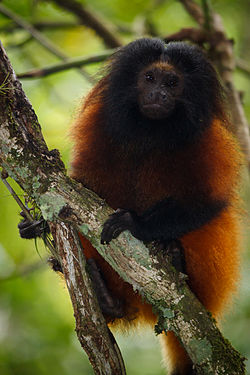Lion tamarin
Genus of New World monkeys From Wikipedia, the free encyclopedia
The four species of lion tamarins or maned marmosets make up the genus Leontopithecus. They are small New World monkeys named for the mane surrounding their face, similar to the mane of a lion.
| Lion tamarins[1][2] | |
|---|---|
 | |
| Golden lion tamarin (Leontopithecus rosalia) | |
| Scientific classification | |
| Domain: | Eukaryota |
| Kingdom: | Animalia |
| Phylum: | Chordata |
| Class: | Mammalia |
| Order: | Primates |
| Suborder: | Haplorhini |
| Infraorder: | Simiiformes |
| Family: | Callitrichidae |
| Genus: | Leontopithecus Lesson, 1840 |
| Type species | |
| Leontopithecus makikina | |
| Species | |
|
Leontopithecus rosalia | |
| Synonyms | |
| |
Description
Living in the eastern rainforests of Brazil, like all other callitrichids they are arboreal. Lion tamarins weigh up to 900 grams (32 oz) and are about 30 cm (12 in) long, with tails about 45 cm (18 in) long. They jump through trees using their fingers to hold on to branches; they use their claws to dig under the bark to search for insects to eat. They also eat some snakes, small lizards, and small fruits. All are endangered or critically endangered, in part because their habitat has been severely disrupted by human development and climate change.[3]
Lion tamarins tend to live in family groups, with both parents sharing different tasks of rearing the yearly twins born to them. The mother nurses her young every two to three hours, and the father carries the babies on his back.
Diurnal tree-dwellers, they sleep in tree cavities at night. They also seek shelter during the hottest part of the day.
Species list
The different species of lion tamarins are easily discernible from each other, based upon the coloration of their fur:[1]
| Common name | Scientific name and subspecies | Range | Size and ecology | IUCN status and estimated population |
|---|---|---|---|---|
| Golden lion tamarin | Leontopithecus rosalia (Linnaeus, 1766) |
southeastern Brazil |
Size: golden fur all over, mane sometimes darkening or black Habitat: Diet: |
EN
|
| Golden-headed lion tamarin | Leontopithecus chrysomelas (Kuhl, 1820) |
Bahia, Brazil |
Size: black fur with golden face, arms, and tail Habitat: Diet: |
EN
|
| Black lion tamarin or golden-rumped lion tamarin | Leontopithecus chrysopygus (Mikan, 1823) |
São Paulo, Brazil |
Size: black fur with a dark gold rump Habitat: Diet: |
EN
|
| Superagui lion tamarin or black-faced lion tamarin | Leontopithecus caissara Lorini & Persson, 1990 |
southeastern Brazil |
Size: Habitat: golden fur with black face, arms, and tails Diet: |
EN
|
Conservation
Climate change has been affecting the lion tamarins in that cocoa production has taken over their habitat. Mass produced cocoa has been found to thin out surrounding canopy trees in the area. These trees are where lion tamarins mostly reside throughout the day.[citation needed]
See also
- Tamarin, genus Saguinus
References
External links
Wikiwand - on
Seamless Wikipedia browsing. On steroids.




